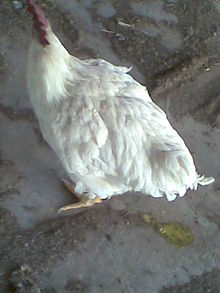
Back كوليرا الدجاج Arabic Cholera drůbeže Czech Geflügelcholera German Kokoĥolero Esperanto Cólera aviar Spanish Choléra des poules French Kolera unggas ID Colera aviare Italian 家禽コレラ Japanese 가금 콜레라 Korean

Fowl cholera is also called avian cholera, avian pasteurellosis and avian hemorrhagic septicemia.[1]
It is the most common pasteurellosis of poultry. As the causative agent is Pasteurella multocida, it is considered to be a zoonosis.
Adult birds and old chickens are more susceptible. In parental flocks, cocks are far more susceptible than hens.[2]
Besides chickens, the disease also concerns turkeys, ducks, geese, raptors, and canaries. Turkeys are particularly sensitive, with mortality ranging to 65%.[3]
The recognition of this pathological condition is of ever increasing importance for differential diagnosis with avian influenza.
- ^ K.R. Rhoades and R.B. Rimler, Avian pasteurellosis, in "Diseases of poultry", ed. by M.S. Hofstad, Iowa State University Press, Ames, Iowa, USA ISBN 0-8138-0430-2, p. 141.
- ^ Hassan Iraqui, Observation on an outbreak of fowl cholera in a parental broiler flock, Azrou, Morocco, October 2007, unpublished data.
- ^ Alberts and Graham (1948), quoted in "Diseases of poultry", op. cit.
© MMXXIII Rich X Search. We shall prevail. All rights reserved. Rich X Search